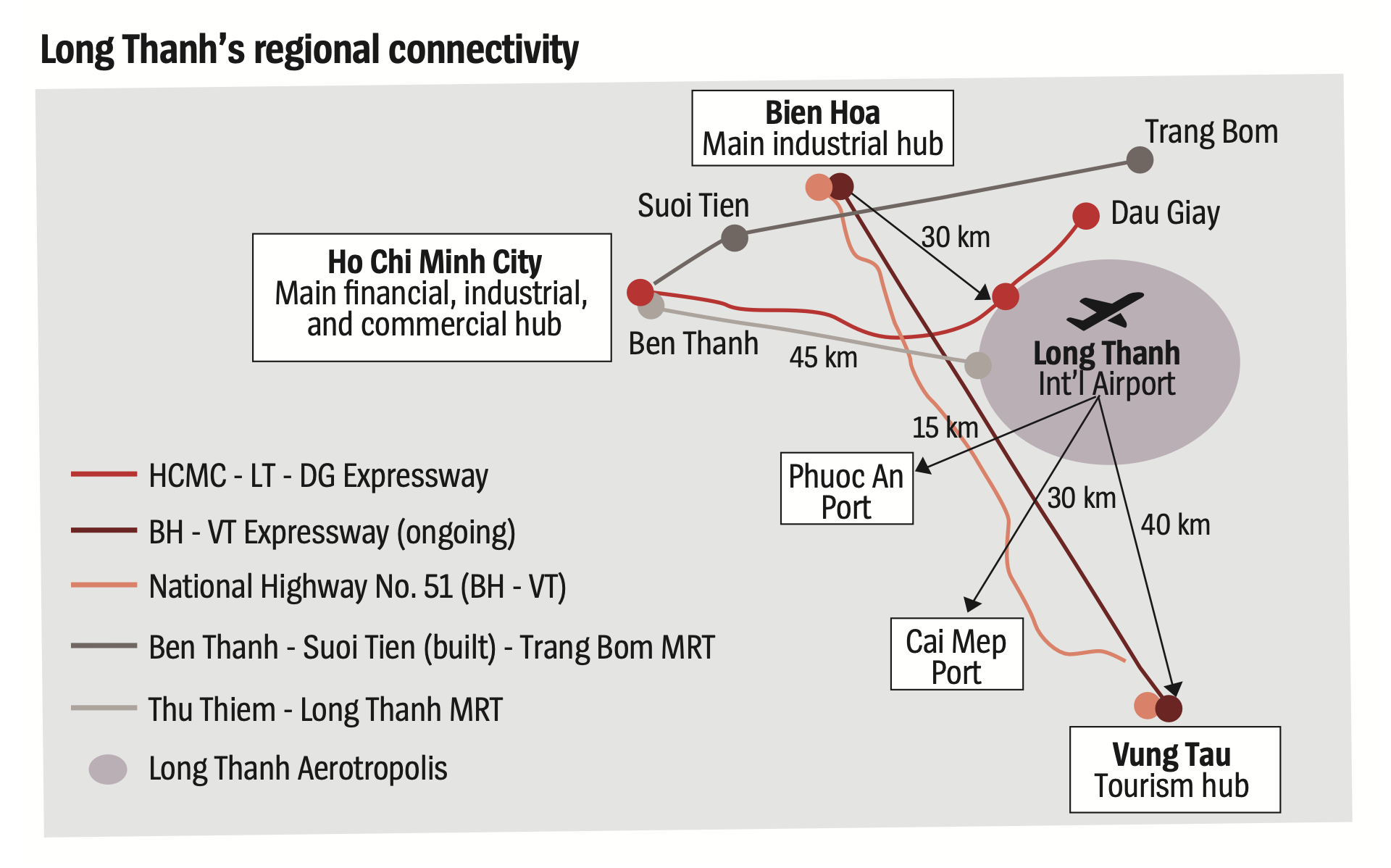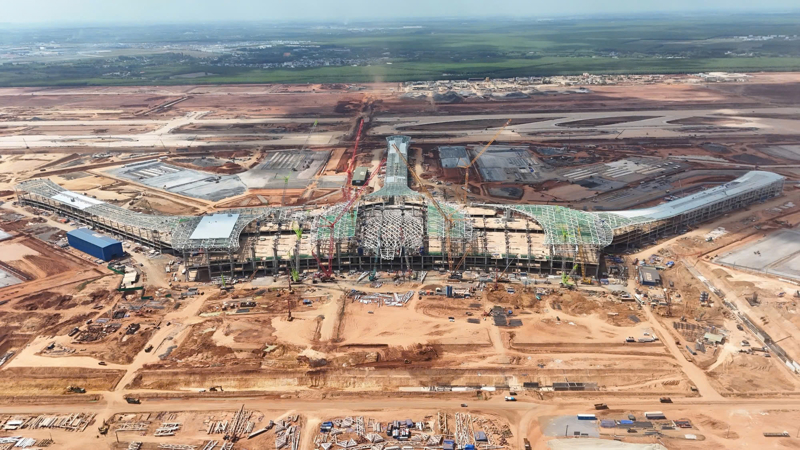Long Thanh International Airport is not merely a large-scale facility but is also intended to restructure the national aviation network. In order to avoid falling into a trap of being “big but isolated”, however, it must be positioned within a regional development framework, guided by integrated planning, multimodal connectivity, and a long-term vision for an airport city.
Prime location
With its prime geographic location in southern Dong Nai province, near Ho Chi Minh City, Long Thanh International Airport is poised to become a strategic international gateway and a vital node along the India-Pacific economic corridor.
On the aviation map of Asia-Pacific, Vietnam sits at the end point of many transcontinental West-East air routes. This gives Long Thanh a naturally favorable position to emerge as a key international hub.
Among regional players, Long Thanh holds a competitive edge as a logistics and transshipment center, even when compared to Suvarnabhumi Airport in Bangkok or Singapore’s Changi Airport.
At the national level, Long Thanh lies at the heart of Vietnam’s Southern Key Economic Region. It links major traffic arteries, including the Tan Son Nhat - Long Thanh - Dau Giay Expressway and the Long Thanh - Cai Mep transport corridor. These connections reinforce its role as a national gateway airport and as one of the three main pillars supporting the region’s logistics network, alongside Ho Chi Minh City’s Tan Son Nhat International Airport and Cai Mep deep-water port.
The surrounding area has become increasingly attractive to investors, both domestic and foreign, thanks to its superior connectivity and access to high-value logistics services.
Given its central position in the Asia-Pacific region, the development of Long Thanh as an international air cargo hub could turn Vietnam into a destination for multinational headquarters, commercial and financial centers, and global conferences. It also opens doors for tourism, healthcare, cultural exchange, and international sporting events - all contributing to raising the country’s international profile.

A true airport city
According to Associate Professor Tran Quang Phu, Vice President of the Ho Chi Minh City University of Transport, the concept of an “integrated airport city”, or Aerotropolis, is an inexorable global trend. It goes far beyond building a modern airport - it requires coordinated planning of surrounding urban areas, industrial parks, logistics hubs, commercial centers, and service clusters. These must be linked through a multimodal transport network, including expressways, metro lines, railways, and rapid bus systems. In this model, the airport becomes not just a transportation hub but a driving force of regional economic growth.
Lessons from successful global models have clearly demonstrated its potential. In South Korea, Incheon International Airport in Seoul is a prime example. To improve access to the airport, the South Korean Government built a dedicated 36-km expressway, complemented by the Seoul Metro system, the high-speed Airport Express (AREX), and a color-coded BRT (Bus Rapid Transit) network, all managed through an ITS (Intelligent Transport System) and integrated T-money smart card payment. With such seamless and convenient connectivity, passengers travel efficiently, and the airport becomes a key driver of regional development.
The Netherlands offers another successful model with Amsterdam’s Schiphol Airport, which functions not only as an air hub but also as a center for logistics, commerce, and international transport. It connects to Brussels and Paris within two to four hours via international rail, and is supported by a dense network of metro lines, trams, public bike systems, and canal-linked shipping routes through nearby Rotterdam Port. This integrated model attracts FDI, creates hundreds of thousands of jobs, and boosts regional GDP.
These examples highlight the need for Long Thanh International Airport to be developed as a multifunctional urban-industrial-service hub, with the airport at its core. Surrounding areas could include an air logistics center, a free trade zone, a high-tech park, an aviation industry cluster, an international convention and exhibition center, and residential areas for professionals. This ecosystem must be tightly connected to surrounding cities and provinces via expressways, metro lines, and interprovincial roads.
Long Thanh should not be seen as just a national airport but as a regional airport city. Under such a vision, planning, investment, operations, and regulatory frameworks must follow an integrated, long-term approach - prioritizing connectivity, supported by urban development, and driven by business.
If executed properly and cohesively, Long Thanh will become more than a transportation hub, it will be central to positioning Vietnam’s aviation sector on the regional map. But if development stops at basic infrastructure, without network connectivity, flight routes, long-term spatial planning, or mechanisms to unlock private investment, it risks repeating the “big but isolated” fate of other underutilized airports.
Connectivity matters
With its vision of becoming a modern airport city integrating logistics, innovation, and international transit, Long Thanh International Airport cannot operate effectively without a well-prepared and synchronized infrastructure network from the outset. Its full potential can only be realized if both on-site and off-site infrastructure are planned and implemented in sync, both in timing and approach.
Recognizing this, the Vietnamese Government has designated a series of key transportation projects to be developed in tandem with the airport’s construction. Major expressways such as Bien Hoa - Vung Tau, Ben Luc - Long Thanh, Dau Giay - Phan Thiet, and Ho Chi Minh City Ring Road No. 3 are being accelerated to form a multidirectional transport spine for the southern region.
In practice, however, gaps remain between project groups. While centrally-managed expressways have seen clearer progress, locally-managed connections, especially provincial roads, still face hurdles in site clearance, funding, and phased implementation. The absence of a regional coordination mechanism has resulted in fragmented development, increasing the risk of delayed integration and reduced overall efficiency.
Many experts believe the broader Long Thanh area should be designated a special development zone with a dedicated coordination framework between central and local governments. Three key development corridors have already been identified: the North - South axis (Bien Hoa - Vung Tau), the West - East axis (via Provincial Road No. 770B), and the Ho Chi Minh City axis (through the Thu Thiem - Long Thanh route). However, if each locality implements its segment independently, technical and scheduling conflicts are likely to arise.
Beyond physical infrastructure, transport organization must also be aligned. Associate Professor Vo Tri Hao from the University of Economics and Law at the Vietnam National University, Ho Chi Minh City, emphasized that for Long Thanh to become a true transit hub it must be supported by an effective public transport system, especially with Ho Chi Minh City.
On the cargo side, the North-South high-speed rail project includes a planned stop at Long Thanh, but remains in search of investors and is unlikely to be launched in time for the airport’s opening. Without a dedicated rail corridor for air cargo, the airport’s logistics potential, particularly for high-value goods, will be limited in both speed and scale. Early groundwork is essential to avoid future patchwork solutions.
Long Thanh proves that infrastructure must not be an afterthought, but a built-in condition for success. This is especially relevant as several provinces propose building new airports. The key is to shape a rational national aviation network, avoiding scattered investments and overlapping functions. Each airport should be clearly positioned, whether for regional transit, domestic traffic, or specialized services.
It may be a national-level project, but Long Thanh International Airport also reflects the need for integrated thinking in aviation infrastructure. When connectivity is planned from the ground up, with transport networks serving not only mobility, but also logistics, urban growth, and production value chains, the airport can drive real economic impact. It becomes more than a destination. It becomes a development engine. And this is the mindset Vietnam must adopt if it hopes to build a competitive, coordinated, and future-ready airport network.









 Google translate
Google translate